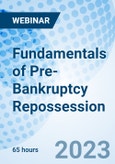Gain an understanding of pre-bankruptcy repossession laws and how to stay compliant during the process.
This presentation will discuss how a creditor determines if their collateral is secured properly. You will learn the steps of how to repossess, and make sure that state laws are followed. The material will also explain what happens if the secured creditor uses the court system to seize the collateral. Lastly, this topic includes what happens if a debtor alleges wrongful repossession, and what to do if the debtor files for bankruptcy.
Learning Objectives
- You will be able to explain what happens if the debtor files bankruptcy.
- You will be able to discuss judicial remedies if the bank cannot repossess the collateral.
- You will be able to identify wrongful repossession.
- You will be able to describe the repossession of the collateral.
Agenda
- Repossession of the Collateral - Is It Properly Secured?
- Repossession of Property
- Judicial Remedies If the Bank Cannot Repossess the Collateral
- Wrongful Repossession
- What Happens If the Debtor Files Bankruptcy?
Speakers

Lynda L. Laing,
Strauss Factor Laing & Lyons- Partner in the office of Strauss Factor Laing & Lyons
- Practice emphasizes all aspects of creditor’s rights and bankruptcy
- Conducts regular seminars and workshops on skip tracing and collections
- Author of several publications related to the areas of skip tracing and collections
- Achieved the highest rating with Martindale-Hubbell Law Directory
- Member of the NARCA, RIBA and CLLA
- Named Super Lawyer
- J.D. degree, Case Western Reserve Law School; B.A. degree, Albion College
- Can be contacted at 401-456-0700 or llaing@straussfactor.com
Who Should Attend
This live webinar is designed for attorneys, presidents, vice presidents, branch managers, loan officers, loan department personnel, credit and collection managers, and accountants.









